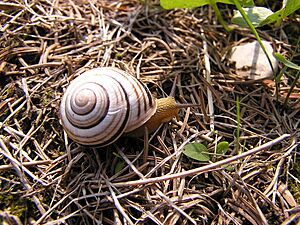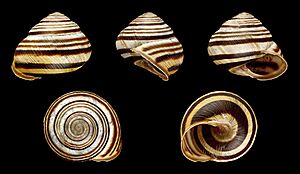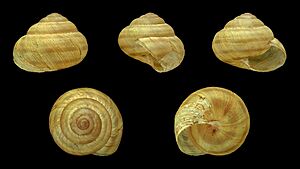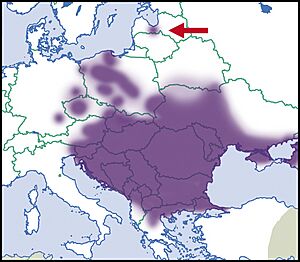Caucasotachea vindobonensis facts for kids
Quick facts for kids Caucasotachea vindobonensis |
|
|---|---|
 |
|
| Conservation status | |
| Scientific classification |
Caucasotachea vindobonensis is a large land snail that breathes air. It's a type of gastropod in the Helicidae family. You might know it as a common garden snail!

This snail's scientific name comes from an old Celtic town called Vindobona, which is now Vienna, the capital of Austria. This snail used to be called Cepaea vindobonensis. But scientists studied its DNA and found it wasn't closely related to Cepaea snails. So, they moved it to a different group called Caucasotachea.
Meet the Caucasotachea vindobonensis Snail!
The shell of the C. vindobonensis snail is round and coils to the right. It's about 17–21 mm tall and 20–25 mm wide. It has about 5.5 to 6 turns, called whorls. In adult snails, the central hole, called the umbilicus, is completely covered.
The edge of the shell opening, called the lip, is brown on the inside. It gets lighter towards the top edge, called the suture. This helps tell it apart from similar snails. For example, the Cepaea hortensis usually has a white lip. The Cepaea nemoralis often has a dark brown lip. These snails sometimes live in the same places as C. vindobonensis.
Another difference is that C. vindobonensis shells have fine ridges from growth. Cepaea shells are usually smooth. The shell is whitish or yellowish. It typically has 5 brown stripes. The top two stripes are usually faint. The lowest stripe is closer to the central pillar, called the columella, than in Cepaea snails. The snail's body is yellowish with grey feelers, called tentacles.
Where Does This Snail Live?
This snail is found in areas around the Black Sea, the Pannonian Plain, and the Balkans.
You can find C. vindobonensis in many countries. These include Albania, Austria, Bulgaria, Bosnia and Herzegovina, Croatia, and the Czech Republic. It's considered "near threatened" in the Czech Republic. Its westernmost location in Europe is in Western Bohemia, but it's not native there.
It also lives in Germany, where it was reintroduced, Greece, Hungary, Italy, Latvia, Macedonia, Moldova, Poland, Romania, Slovakia, and Slovenia. In Russia, it's found in Rostov Oblast, Stavropol Krai, Krasnodar Krai, and the Moscow Region, but it's not native to these areas. It also lives in Ukraine. In 2021, people found new groups of these snails in the United States (New York State) and Canada (Quebec).
The snail's first home was probably open forests in the Balkans. After the last ice age, it spread across much of Central and Eastern Europe. Today, it also lives in many grassy places. These include meadows, steppes (dry grasslands), and disturbed areas like roadsides. In Southern Bulgaria, it can live as high as 1600 meters above sea level.
The Snail's Life Cycle
Most of what we know about this snail's life comes from a study in Greece. Since Greece is in the south, the snail's life cycle might be different in colder, northern countries.
According to the Greek study, C. vindobonensis snails become adults after their second year. They can live for about 7 years. In Greece, they lay eggs from April to June, with most eggs laid in May. Each snail lays about 29 to 67 eggs. The eggs are about 3 mm wide. Young snails hatch after about 18 days.
During hot summer days, these snails rest. They attach themselves to leaves or tall plant stems. They start their winter sleep, called hibernation, in late October or early November. They wake up from hibernation in March.






